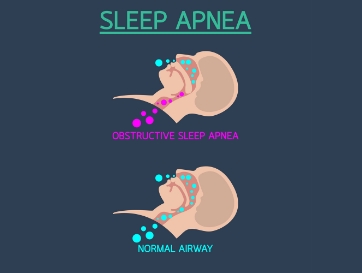Obstructive sleep apnea (OSA) is a common sleep disorder characterized by repeated episodes of complete or partial obstruction of the upper airway during sleep. It is a serious condition that can significantly impact sleep quality and overall health. In this article, we will explore the causes, symptoms, and available treatment options for obstructive sleep apnea.

Obstructive sleep apnea occurs when the muscles in the back of the throat fail to keep the airway open during sleep. Several factors contribute to this obstruction:
Excessive Weight : Being overweight or obese increases the risk of developing obstructive sleep apnea due to the presence of excess fat in the neck area, which can narrow the airway.
Narrowed Airway : Some individuals naturally have a narrower airway, making them more prone to experiencing obstructions during sleep.
Age : As individuals age, the muscles in the throat may lose their tone, making them more susceptible to airway collapse.
Genetics : Family history and genetics can play a role in the development of obstructive sleep apnea.
Lifestyle Factors : Smoking, alcohol consumption, sedative use, and poor sleep habits can contribute to the occurrence of sleep apnea episodes.

he following signs and symptoms may indicate the presence of obstructive sleep apnea:
Loud and Chronic Snoring : Intermittent or persistent loud snoring is a common symptom of obstructive sleep apnea.
Excessive Daytime Sleepiness : Individuals with sleep apnea often feel excessively tired or fatigued during the day, even after what should be a full night's sleep.
Witnessed Breathing Pauses : Episodes of breathing cessation during sleep may be observed by a bed partner or family member.
Gasping or Choking Sensations : Some individuals with sleep apnea may wake up abruptly with a sensation of gasping for air or choking.
Morning Headaches : Frequent morning headaches can be a symptom of obstructive sleep apnea due to the impact on oxygen levels during sleep.
Yes, it can be effectively managed with appropriate treatment and lifestyle modifications.
Yes, obstructive sleep apnea can occur in children, often due to enlarged tonsils or adenoids.
Diagnosis is typically made through a sleep study called a polysomnography, which measures various physiological parameters during sleep.
While snoring can be a symptom of obstructive sleep apnea, not all snorers have sleep apnea.
In mild cases, lifestyle changes like weight loss, regular exercise, and avoiding certain substances may effectively manage obstructive sleep apnea.
Untreated obstructive sleep apnea can increase the risk of high blood pressure, heart disease, stroke, diabetes, and other serious health conditions.
“Obstructive sleep apnea is a prevalent sleep disorder that can have significant implications for an individual's well-being. Recognizing the signs and symptoms and seeking appropriate treatment is crucial for improving sleep quality and reducing associated health risks. Consult with a healthcare professional to determine the best course of action if you suspect you or a loved one may be experiencing obstructive sleep apnea.”